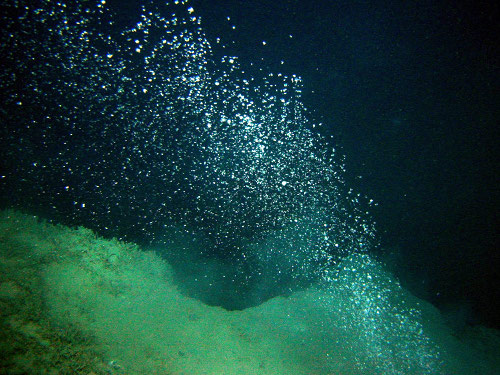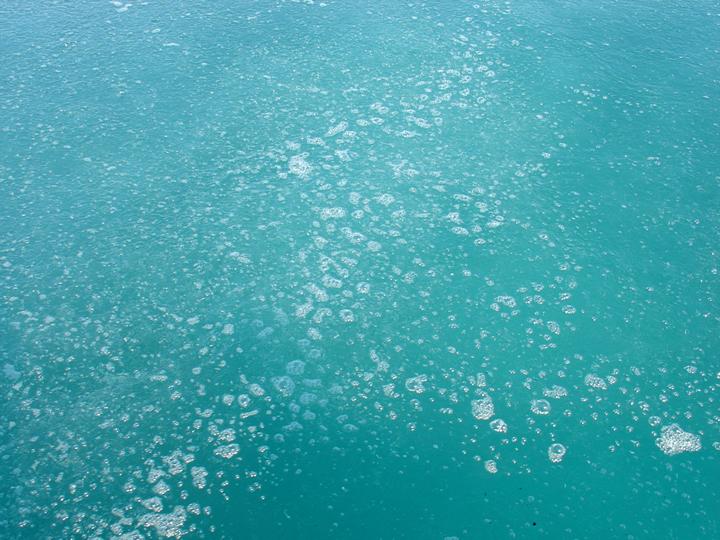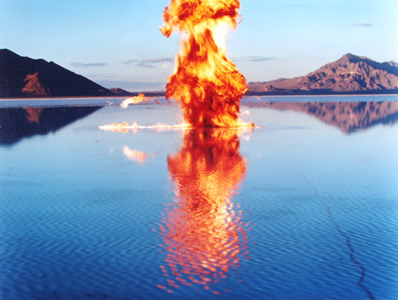It looks like you're using an Ad Blocker.
Please white-list or disable AboveTopSecret.com in your ad-blocking tool.
Thank you.
Some features of ATS will be disabled while you continue to use an ad-blocker.
share:
originally posted by: nataylor
a reply to: smurfy
Except, there's no way a volcano could go from 10,000 feet deep to breaking through the surface in a mater of years (the last major bathymetric survey in the area was in 2008). You don't see 10,000 foot volcanic mountains popping up overnight.
Again, sources please.
Appearing overnight, no... but seeing the lava for the first time, could definitely have happened in a short period of time from when it would not be visible.
You are also assuming that just because there was a survey done in 2008, that they (whoever did the survey) also knew or were able to determine if it was active or not. I doubt that to be the case since bathymetry is just the surveying, it takes other methods to determine volcanism.
You are claiming that a volcano can't go from 10,000 feet to breaking through the surface in a matter of years?
I guess we can say you probably aren't a volcanologist by profession....
Let's do some math based your bathymetry claim... first, a source to consider from what most would consider a reputable source, the journal Nature:
Most of Earth’s volcanoes are under water. As a result of their relative inaccessibility, little is known of the structure and evolution of submarine volcanoes. Advances in navigation and sonar imaging techniques have made it possible to map submarine volcanoes in detail, and repeat surveys allow the identification of regions where the depth of the sea floor is actively changing. Here we report the results of a bathymetric survey of Monowai submarine volcano in the Tonga–Kermadec Arc, which we mapped twice within 14 days. We found marked differences in bathymetry between the two surveys, including an increase in seafloor depth up to 18.8 m and a decrease in depth up to 71.9 m. We attribute the depth increase to collapse of the volcano summit region and the decrease to growth of new lava cones and debris flows. Hydroacoustic T-wave data reveal a 5-day-long swarm of seismic events with unusually high amplitude between the surveys, which directly link the depth changes to explosive activity at the volcano. The collapse and growth rates implied by our data are extremely high, compared with measured long-term growth rates of the volcano, demonstrating the pulsating nature of submarine volcanism and highlighting the dynamic nature of the sea floor.
Source
So... let's take 365 days in a year, and divide that by 14 days in their sampling. That gives us roughly 26.
That's how many samplings could be done in a year. Then let's assume that the growth is constant in every sampling of 18.8 meters. That would give us an annual growth of 488.8 meters per year.
You said the last sampling was 2008, so that is 6 years ago.
488.8 meters a year x 6 years = 2,932 meters.
2,932 meters x 3.28 to convert to feet = 9,619 feet.
I would say that's damn close enough to demonstrate that you are wrong.
Even if we don't assume the growth is constant, there is not active monitoring of the volcanic seafloor, and 6 years ago, lava flows from that volcano would not be visible. Give it 6 years to be active, and at a rate equivalent to what has been OBSERVED in other submarine volcanoes, and it is very easy to see how this could be a volcano.
You might want to rethink your hypothesis.
~Namaste
edit on 26-8-2014 by SonOfTheLawOfOne because: (no reason given)
edit on 26-8-2014 by SonOfTheLawOfOne because: (no reason
given)
I agree with others, this pilot seems a legitimate witness. What did he see? What about a meteorite exploding in midair? Explaining the short flash,
sending light down, but also up? They were still 30 minutes away from the spot. At the spot they see large blobs, different colours. Could these be
sinking, hot remains of an exploded meteorite?
Perhaps it should be taken into account the vast amount of video evidence showing U.F.O.'s flying in and out of volcanoes all around the world.
Especially at Popocatépetl. footage and reports have been on the rise for the past few years. This event may be related.
'
originally posted by: 8675309jenny
Could you ask the photographer if the lights on the ocean surface appeared to move at all?? Like actual lava flows, or did they seem to be stationary? or maybe some flickering of the light?
I'm starting to wonder if some of those seafloor methane vents could have caught fire somehow and we have flaming bubbles of methane rising to the surface...
Done, this time he gave me the reply in english, so that I didn't have to translate it:
The lights were stationary, not flickering and of a constant glow. The colors were not changing, the intensity neither.
They appeared not to move at all, though the cloudlayer prevented us from seeing the source of the lights directly.
Also, I have been told that a number of scientist have shown an interest, and have contacted him, along with various news sites.
At this moment sattelite images are being viewed to check if there is anything to see there. To be continued..
Hmmm I take long exposure pictures and this pictures are to sharp and stars are not showing trails. Unless you took this pictures from a ufo
stationary I dont believe this. 8sec exposure on a tripod will create startrails and this was taken from a plane and no star trail? Fishyyyyy
Light passing through smog from china.
We see this some times in calif if the jet stream is just right.
We see this some times in calif if the jet stream is just right.
a reply to: cdesigns
Already have been explained:
www.abovetopsecret.com...
www.abovetopsecret.com...
www.abovetopsecret.com...
Many others including myself have explained but his posts are way better and in detail.
Nothing fishy about it.
8sec exposure on a tripod will create startrails and this was taken from a plane and no star trail? Fishyyyyy
Already have been explained:
www.abovetopsecret.com...
www.abovetopsecret.com...
www.abovetopsecret.com...
Many others including myself have explained but his posts are way better and in detail.
Nothing fishy about it.
originally posted by: Rezlooper
originally posted by: Phage
a reply to: Rezlooper
Here is a pic from below of the methane bubbles rising to the surface in the Arctic.
No.
That is a picture of bubbles from scuba divers rising to the surface. Perhaps in the Arctic but probably not.
It's a facebook "cover".
www.timelinecoverbanner.com...
Haven't seen ya around Phage, good to see you. And that's your contribution to this thread. Sure did miss your wit around here!
Anyways, since that was so important to point out that these aren't methane bubbles, sorry my bad. But, here are a few more pics, and then, I'll ask the question again...could these pics in the OP be ignited methane bubbles?
The Resilient Earth
Green house Nuetral Foundation
woods Hole Oceanographic Institution
And here is a photo of a bubble exploding on a lake
Source
I asked the question of these pics in the OP could be methane bubbles like these above.
Could there have been a large methane gas eruption...thawing of the frozen methane hydrates due to the warming deep ocean temps, and somehow the gas caught fire? I'm not sure about this, but I was wondering if these terrestrial gamma ray bursts another poster mentioned (usually caused by lightning storms) could be caused by, say, enough energy if there were a powerful explosion of methane gas from below, identical to those blowholes discovered in Siberia. This would explain the strange lightning observation 30 minutes earlier. The gamma ray flash, in turn, ignites the gas bubbles and you have the photo op the pilot took later, as the bubbles still burned. I'm no expert on terrestrial gamma ray bursts, but, as far as I know, they are thought to be produced from high-energy lightning;
It is presumed that TGF photons are emitted by electrons traveling at speeds very close to the speed of light that collide with the nuclei of atoms in the air and release their energy in the form of gamma rays
Wikipedia
Could other explosive sources provide this type of energy?
a reply to: cdesigns
No not fishy, fisheye lens are the words you were looking for, 10.5mm, 180 degree angle, high ISO, together with the distance and some other factors which already have been covered by ATS members earlier in the thread. With a max shutter of 30 seconds a sharp photo can be produced.
No not fishy, fisheye lens are the words you were looking for, 10.5mm, 180 degree angle, high ISO, together with the distance and some other factors which already have been covered by ATS members earlier in the thread. With a max shutter of 30 seconds a sharp photo can be produced.
edit on
26-8-2014 by AnonymousWitness because: (no reason given)
a reply to: Deaf Alien
I have a Nikon j1 and a Nikon D5300 (not a D800) but I do have high ISO too. And I have taken thousands of long exposure pictures with stock lens, primes and thru telescopes and even with the angle and all the geometry stuff you guys are talking about is imposible for a 8sec picture not to have a startrails specially the stars in the edges of the picture. In 8sec just a few mm of movement of that plane left/right/up/down will create blur or trails on those stars. Even on 3sec. Exposure will be hard to do.
I have a Nikon j1 and a Nikon D5300 (not a D800) but I do have high ISO too. And I have taken thousands of long exposure pictures with stock lens, primes and thru telescopes and even with the angle and all the geometry stuff you guys are talking about is imposible for a 8sec picture not to have a startrails specially the stars in the edges of the picture. In 8sec just a few mm of movement of that plane left/right/up/down will create blur or trails on those stars. Even on 3sec. Exposure will be hard to do.
After looking at the pictures for the second time, the second picture shows the orange lights in the bottom (earth surface) you are going to tell me
that in 8sec those lights on the bottom are not going to move when you are in plane at hundreds of mph????? the only blur I see is even in all corners
not from moving, but from mist or clouds..............When you are in a plane at night, the sky doesn't move much but when you look to the ground,
you will see movement, houses and light poles are going to come in/out out of the frame of the window and specially in a period of 8sec. you will see
a lot movement if its a long exposure picture.
8 SEC IMPOSSIBLE, 1/8 of a sec might be possible but not even with the Highest ISO on that camera you will get that resolution.
8 SEC IMPOSSIBLE, 1/8 of a sec might be possible but not even with the Highest ISO on that camera you will get that resolution.
a reply to: cdesigns
I don't think you really understood those posts.
Also take a look at this video (start around 1 minute mark). This is an airplane preparing to land.
Pay attention to the background and see how much it changes. This plane flew LOW. Also notice there is no shaking.
I don't think you really understood those posts.
Also take a look at this video (start around 1 minute mark). This is an airplane preparing to land.
Pay attention to the background and see how much it changes. This plane flew LOW. Also notice there is no shaking.
This is what I believe it happened


edit on 26-8-2014 by cdesigns because: (no reason given)
originally posted by: Rezlooper
And here is a photo of a bubble exploding on a lake
THIS is what I was imagining it may look like on the ocean surface there, except huge clusters of it!
Also the plane traveled 20miles from the second image to the third, so the red glowing whatever-it-is, is spread out over a large area.
There's no smoke without fire , or there's no fire without smoke !
Here's some similar glowing seas.
Milky seas ?
On a dark winter’s night in 1995 a merchant vessel traveling off the coast of Somalia encountered massive expanse of brightly glowing waters similar to those reported for centuries by other mariners traversing the waters of the northwestern Arabian Sea
www.eumetsat.int... ion=Web
Midnight sea turns blue ?
www.dailymail.co.uk...
Here's some similar glowing seas.
Milky seas ?
On a dark winter’s night in 1995 a merchant vessel traveling off the coast of Somalia encountered massive expanse of brightly glowing waters similar to those reported for centuries by other mariners traversing the waters of the northwestern Arabian Sea
www.eumetsat.int... ion=Web
Midnight sea turns blue ?
www.dailymail.co.uk...
a reply to: Deaf Alien
you proved my point, count 8 seconds and you will notice how many lights of buildings come in and of the frame, they don't stay steady even if on how slow they look, take that to a long exposure picture of 8sec and you will have something like this.
bottom ground lights are blurry while the camera is steady taking a picture of the engine, in 8sec you will have more blur than this.

you proved my point, count 8 seconds and you will notice how many lights of buildings come in and of the frame, they don't stay steady even if on how slow they look, take that to a long exposure picture of 8sec and you will have something like this.
bottom ground lights are blurry while the camera is steady taking a picture of the engine, in 8sec you will have more blur than this.

a reply to: cdesigns
No I didn't prove your point. As I have said that airplane flew LOW (emphasis on LOW) and yet the background still moved slowly.
We are talking about that airplane in the pictures being 34K feet HIGH.
No I didn't prove your point. As I have said that airplane flew LOW (emphasis on LOW) and yet the background still moved slowly.
We are talking about that airplane in the pictures being 34K feet HIGH.
To steady the camera, you simply brace it against the _ The wide angle lens lessens the problem also, but MOST IMPORTANTLY, if you are looking down at 20° from horizontal at 34,000ft, your objects are 99,409ft away!! At a low angle the 30second exposure is perfectly fine. Your example of 8secon exposures are for objects that are a mere 50ft away or so. Anything on the surface of the ocean in these pictures is a MINIMUM 34,000ft away.
originally posted by: cdesigns
8 SEC IMPOSSIBLE, 1/8 of a sec might be possible but not even with the Highest ISO on that camera you will get that resolution.
at 978feet per second, 8 seconds = 7,824 ft So take our previous 45° viewing angle (assumed) and figure out the change in angle over 8seconds by subtracting the difference. (new right triangle 26,176ft x 34,000 )
The new viweing angle is 37.6 degrees (a pretty noticeable change of 7.4degrees). 7.4°/180° = 0.04111111 aka 4% change.
Not enormous, but you can clearly see the forward motion blur in image. I don't know what crystal clear pictures you're referring to.
You photography people trying to call this a hoax clearly do not understand the mathematical capabilities and limitations of the equipment. Just because YOU have not taken such pictures, doesn't mean it's impossible.
You guys are completely misunderstanding how range affects angular velocity.
new topics
-
Traveling the world with no passport
Social Issues and Civil Unrest: 2 hours ago -
Happy Thanksgiving to ATS
General Chit Chat: 5 hours ago
top topics
-
Mind Blowing Cave under someones land
Fragile Earth: 16 hours ago, 17 flags -
The Party of Peace - Trump Cabinet Picks Targeted with Death Threats
US Political Madness: 17 hours ago, 15 flags -
Simple Thanksgiving
Food and Cooking: 12 hours ago, 15 flags -
Trump Presidential Transition Team will not use GSA or Government entities to come to DC
US Political Madness: 16 hours ago, 14 flags -
Trump could make a peaceful American Revolution
US Political Madness: 15 hours ago, 14 flags -
Happy Thanksgiving to ATS
General Chit Chat: 5 hours ago, 6 flags -
Traveling the world with no passport
Social Issues and Civil Unrest: 2 hours ago, 5 flags
active topics
-
Simple Thanksgiving
Food and Cooking • 28 • : yeahright -
Petition Calling for General Election at 564,016 and rising Fast
Political Issues • 107 • : gortex -
Traveling the world with no passport
Social Issues and Civil Unrest • 2 • : AdultMaleHumanUK -
I thought Trump was the existential threat?
World War Three • 116 • : andy06shake -
Well, here we go red lines crossed Biden gives the go ahead to use long range missiles
World War Three • 402 • : andy06shake -
Mind Blowing Cave under someones land
Fragile Earth • 18 • : Flyingclaydisk -
D.B. Cooper mystery may be solved
General Conspiracies • 22 • : andy06shake -
Happy Thanksgiving to ATS
General Chit Chat • 4 • : VariedcodeSole -
Post A Funny (T&C Friendly) Pic Part IV: The LOL awakens!
General Chit Chat • 7840 • : GENERAL EYES -
Trump Presidential Transition Team will not use GSA or Government entities to come to DC
US Political Madness • 14 • : WeMustCare




